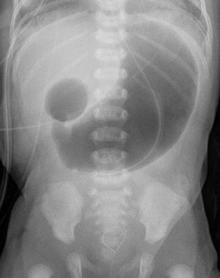| Intestinal atresia | |
|---|---|
| Other names | Bowel atresia |
 | |
| Radiograph with double bubble sign indicating duodenal atresia | |
| Specialty | General surgery |
| Symptoms | Vomiting bile, abdominal bloating, failure to pass meconium[1] |
| Complications | JIA: Short gut syndrome[1] DA: Hirschsprung disease[1] |
| Usual onset | Present at birth[1] |
| Types | Duodenal, jejunoileal, colonic[1] |
| Risk factors | JIA: Gastroschisis, cystic fibrosis[1] DA: Down syndrome[1] |
| Diagnostic method | Before birth: Ultrasound[1] After birth: X-ray[1] |
| Differential diagnosis | Intestinal malrotation, volvulus, Hirschsprung disease[1] |
| Treatment | Nasogastric tube, intravenous fluids, surgery[1] |
| Prognosis | 90% survival[2] |
| Frequency | 1 in 3,000 newborns[1][3] |
Intestinal atresia is a birth defect of the intestines that causes bowel obstruction in the newborn.[1] There are three types duodenal (DA), jejunoileal (JIA), and colonic (CA).[1] Symptoms may include vomiting bile, abdominal bloating, and failure to pass meconium.[1] Complications of JIA may include short gut syndrome while complications of DA may include Hirschsprung disease.[1]
Risk factors for JIA include gastroschisis and cystic fibrosis while risk factors for DA include Down syndrome.[1] Diagnosis may occur by ultrasound before birth and X-ray after birth.[1] Other conditions that may present similarly include intestinal malrotation including volvulus, and Hirschsprung disease.[1]
Initial treatment involves nasogastric tube placement and intravenous fluids.[1] This is than followed by surgery and in JIA parenteral nutrition is often required until intestinal function has improved.[1] Procedurals to lengthen the intestines or small bowel transplant may occasionally be required.[1] The risk of death in DA is about 5% while that in CA is about 25%.[1]
Jejunoileal atresia affects between 1 to 3 in 10,000, while duodenal atresia affects about 1 in 10,000, and colonic atresia affects about 1 in 35,000 newborns.[1][3] The condition is the cause of about a third of cases of bowel obstruction in newborns.[2] It was first described in 1684 by Goeller.[2]
References
edit- ^ a b c d e f g h i j k l m n o p q r s t u v w x Adams, SD; Stanton, MP (December 2014). "Malrotation and intestinal atresias". Early human development. 90 (12): 921–5. doi:10.1016/j.earlhumdev.2014.09.017. PMID 25448782.
- ^ a b c Prasad, T. R. Sai; Bajpai, M. (2000-09-01). "Intestinal atresia". The Indian Journal of Pediatrics. 67 (9): 671–678. doi:10.1007/BF02762182. ISSN 0973-7693.
- ^ a b William J. Cochran, MD. "Jejunoileal Atresia - Pediatrics". MSD Manual Professional Edition. Retrieved 2019-02-03.